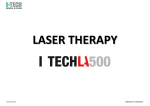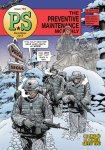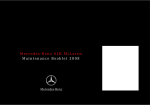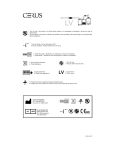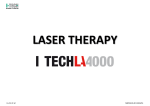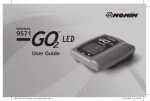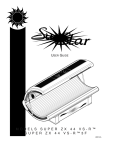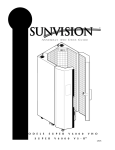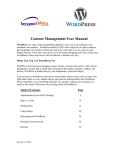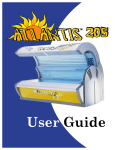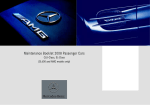Download iowa department of public health (idph)
Transcript
IOWA DEPARTMENT OF PUBLIC HEALTH (IDPH) BUREAU OF RADIOLOGICAL HEALTH Lucas State Office Bldg/5th Floor Des Moines, IA 50319 Website: www.idph.state.ia.us/eh/tanning_facilities.asp TRAINING PROGRAM FOR OPERATORS OF TANNING DEVICES No individual may operate a tanning unit until the individual has completed this training program and passed the required test. Please follow the directions carefully. 1. Study this training booklet and the IDPH Health Warnings and Photosensitizing Drug list. 2. Complete the test as instructed. You may refer to this manual when taking the test. Owner/managers must contact the appropriate county health department to take a test monitored by the county or its representative. See the County Contact list on the website. Employees must pass a test monitored by the owner/manager. If you have any questions, please call (515) 281-0415 PURPOSE The purpose of the regulation of tanning facilities and the requirement of training for operators is to provide a minimum standard for the safe operation of tanning beds and to protect the public health and safety. The misuse of tanning equipment may, in addition to immediate undesirable results, cause permanent damage. Therefore, tanning operators have a responsibility to educate themselves and to operate facilities in a manner that will minimize any adverse effects. Part I. Light and ultraviolet radiation Ultraviolet radiation (UV) is found in sunlight. It is divided according to wavelength with the wavelength measured in nanometers (nm). One nanometer is one-millionth of a millimeter. Ultraviolet light from the sun can be divided into the following three categories: UVA: UVB: UVC: 315-400 nm 280-315 nm 200-280 nm 97% to 99% reaches earth 1% to 3% reaches earth 0 reaches earth UVC is the shortest ultraviolet wave. It does not reach earth's surface because the ozone layer and other components of the atmosphere normally filter it. UVC would destroy most life if it was not filtered. UVC is often referred to as “germicidal” radiation because it is efficient at killing organisms. UVB is usually associated with sunburn. However, UVB is the most efficient wavelength for tanning the outer layer of skin. So, UVB starts the tanning process. UVA is the longest ultraviolet wave. UVA makes up the majority of the light emitted by most current indoor tanning lamp units. UVA darkens skin pigmentation already stimulated by UVB 1 2 and is necessary to complete the tanning process. But it can also cause severe reactions when combined with photosensitizers. Because UVA penetrates into the skin deeper than UVB, it is also responsible for permanent skin damage such as an increase in the incidence of skin cancers and fine wrinkling, premature aging, age spots, and irregular pigmentation of the skin. Most sunlamps give off either mostly UVA or mostly UVB. Some operators and consumers mistakenly believe that with the newer UVA sunlamps, the consumer will not burn because the UVB (or quick-burning wave) is filtered. But the newer UVA sunlamps give off as much as 10 times more UVA than received from the sun or from older UVB sunlamps. Therefore, burning and skin damage is still possible. Low pressure tanning systems use a higher percentage of UVB rays which penetrate only the upper layer of skin and can cause burning easier than high pressure tanning systems. Low pressure systems require more frequent sessions to maintain a tan. High intensity tanning systems use more lamps and shorter tanning sessions than low intensity tanning systems. These are still classified as low pressure systems. High pressure tanning systems use a higher percentage of UVA rays which penetrate deeper and can permanently damage the lower layers of skin and increase the incidences permanent skin damage. High pressure systems require fewer and less frequent sessions to maintain a tan. These units usually have lamps on only one side and require the tanner to turn over during the session. You should know: The difference between UVA and UVB waves. Which UV is used for sun tanning and in your tanning units. The difference between low pressure and high pressure units. Part II. UV light and its effect on the skin. The skin is divided into two main layers. The epidermis is the upper layer and the dermis is the lower layer. In the bottom layer of the epidermis are melanocytes that produce tiny granules of melanin. Skin color is determined by the amount of melanin the melanocytes produce. When exposed to UVB, the skin is stimulated and the melanin darkens and rises to the skin's surface to darken or “tan” the skin. Tanning is the skin's response to exposure of ultraviolet radiation and is the way it protects itself from becoming more damaged by UV rays. Slowly building a tan helps to protect the skin because the tan acts as a shield against further exposure. However, each time the skin is forced to darken itself, it may be damaged permanently. The darkness of the tan is determined by the amount of pigmentation already naturally present in the skin, the skin's capability to build up additional melanin, the area of the body exposed, and the age of the individual. The first phase of tanning can be immediate - color begins immediately and may fade in minutes. The second phase (delayed tanning) is the familiar longer lasting tan induced by repeated exposure to UV. Delayed tanning can be caused by UVB or UVA. UVBinduced tanning is visible after 24 hours and becomes obvious in three to five days. UVAinduced tanning becomes visible within 36 to 48 hours since it goes deeper into the skin. Since results are usually not readily visible for 36 - 48 hours, tanning more frequently than every 48 hours can encourage burning. 2 If the melanin cannot rise quickly enough, erythema or reddening of the skin (commonly called sunburn) occurs. Severe burning may include painful swelling and/or blistering. Burns become visible one-half to eight hours following exposure, reaching maximum at 12 to 24 hours. Burning can only be repaired by the skin's repair mechanism, which can take up to 30 days. Avoiding further exposure is necessary once burning occurs in order to allow the skin to heal itself. Severe burn or chronic overexposure can destroy the cells producing melanin and permanently impair the function of the melanin so it cannot protect the skin properly. Therefore, the skin is more sensitive to UV for the rest of your life The lower skin layer is the dermis. Since UVA penetrates to the dermis and there is no built-in repair mechanism in the dermis, chronic overexposure may cause permanent damage. When UV damages the lower skin layer, the damaging effects from UV may not show up immediately as a burn. The damage may show up years later as skin thickening and wrinkling or cancer. Skin thickening is a skin reaction where both dermis and epidermis become thicker because cells divide more frequently. This leads to a great increase in the epidermal tissue growth rate and thickens the skin. Skin thickening is a natural defense mechanism to protect the body from UV light. Since UV light overexposure has been labeled as the leading cause of skin cancer, you should be familiar with the three basic types of light-induced skin cancer: 1. Basal cell cancer is the most common and least harmful form. Look for a raised pinkish lump, which is smooth-surfaced with a depression in the center that may bleed easily or will not heal. These are most commonly found on the face. 2. Squamous cell cancer most often appears as a sore that will not heal or that has a crusted, heaped-up appearance. It can spread to local lymph nodes and through the lymph nodes to distant body sites. 3. Malignant melanoma is a deadly form of skin cancer that spreads internally. It is the least common form but the number of cases has doubled in the last few years particularly in women under the age of 35. There is a 95 percent cure rate if the malignant melanoma are detected early. The following are indications of melanoma: a. b. c. d. Asymmetry: part of the growth may be shaped differently from the rest of the growth (non-cancerous moles tend to be round). Border: growths often have notched or blurred margins that fade into surrounding skin. Color: an irregular mixture of tan, brown, black, red, blue and white or any combination of these. Diameter: common moles are usually less than ¼ inches. Early melanomas tend to be larger than ¼ inches. Be alert for other warning signs such as new growths, flat areas that become bumps, and areas or spots that bleed, crust, ooze, redden, swell, itch, or change consistency. Encourage consumers to see a doctor immediately if there is any question. Early detection will allow the best cure. Since the ability to tan or burn is dependent on the skin's natural pigmentation, it is important to be able to determine the consumer's skin type as accurately as possible. Skin types range from Type I - always burns, tans little or none, and peels, to Types V and VI, which is naturally dark skin that needs little or no tanning. Therefore, tanning exposure time is usually calculated for skin types I to IV. It is necessary that operators and consumers know how to determine skin 3 4 sensitivity and skin type. Use the chart included with the photosensitizing drug list issued by the IDPH to help determine skin type of the consumer. In addition to the skin type chart, consider these items: 1. Persons who sunburn easily and don't tan in the sun probably won't tan in a tanning bed and shouldn't be using one (Skin type I). 2. Naturally red-haired or blond-haired and blue-eyed persons and/or persons who have skin with freckles, burn easily, tan little, and are more susceptible to long-term skin damage. 3. If in doubt about a consumer's skin type, choose a lighter skin type and start with less tanning time. 4. There is no such thing as a “safe” tan for any skin type. Releasing melanin is the body’s way to protect itself against UV light. You should : Know how UV affects different parts of the skin. Know what melanin is and how it works. Be familiar with the skin type chart and know how to determine skin types. Part III. Photosensitivity Photosensitivity is a condition in which the human skin reacts abnormally to light, especially ultraviolet rays (UVA) or sunlight, because of the presence of medications, hormones, or heavy metals in the body. If a substance is a photosensitizer, it acts in combination with UV light and causes a sensitivity reaction in the skin. If it can be identified, steps can be taken to prevent burning or other reactions while tanning. Normally, this involves simply reducing tanning times and/or removing the substance from the skin. Common photosensitizers are medications, cosmetics, or toiletry items. Symptoms of photosensitivity can be any of the following: 1. 2. 3. 4. Severe burning, often in patches and/or on relatively small areas of the body to what are typically considered small doses of light. Blotchy formation. It can be the result of heat or light. A rash which may or may not cause itching. It may or may not appear all over the body. Uneven pigmentation. It could be the result of light exposure combined with medication or may be a result of non-light-related factors such as a fungus, infections, genetic factors, or pressure points experienced during exposure. Diseases and allergies can also cause photosensitivity. Genetic factors, such as skin type or tendencies toward some diseases, can also play a role. Common diseases that can cause severe reactions when exposed to UV light, are: 1. Psoriasis 2. Lupus erythematosous 3. Porphyria 4. Skin cancer 4 Phototherapy is the use of sunlight or artificial ultraviolet light for the medical treatment of disease and requires a prescription from a doctor. The PUVA treatment is often used in the treatment of skin diseases such as psoriasis. The drug Psoralen used in this treatment is a potent photosensitizer. There are two types of psoralen-type drugs commonly in use: 8-methoxypsoralen (8MOP), and 4.5 trimethylpsoralen. These are potent photosensitizers and anyone using these drugs should not be allowed to use the tanning facility unless the exposure is authorized by a medical doctor. (There is one case of a fatality in Illinois involving the use of psoralen and UV exposure.) Other medications may cause skin reactions also. Please review the IDPH Health Warnings for a more complete list. Tanning times should be reduced and frequencies extended for consumers using medications on the IDPH Health Warnings list or any medication that indicates photosensitivity on the label it is determined that the medication will not cause reactions or burning. Certain foods can also increase photosensitivity. The juices from common foods such as celery, carrots, and citrus fruits may cause photosensitivity when they are on the skin. Operators should shorten tanning times for consumers that work in businesses where the consumer's skin is in contact with these juices. Consumers should also be cautioned against the use of shampoos, soaps, or lotions that contain food extracts when they are using a tanning unit. Photoallergy is a form of allergic reaction caused when light reacts with certain chemicals that are on the skin. Some of these chemicals are: Phenothiazine Hexochlorophene Optical bleaches Certain cleaning agents Sulfonamides Sunscreen agents Topical antihistamines Germicidal cleaners or other harsh type cleansers used to clean acrylic surfaces of tanning beds can leave a residue which may cause photoallergic skin reactions. Many of the disinfectants on the market contain active ingredients such as alcohol, phenylphenol, or ethyl alcohol. Residues from these chemicals may cause skin reactions when combined with UV radiation. Select a cleanser with these things in mind: 1. It must cleanse the surface. 2. It must not harm the acrylic material. 3. It must not cause a skin reaction. Check the tanning unit's user manual for the manufacturer’s recommendations. Substances such as cosmetics, soaps, shampoos, lotions (particularly those with musk), and PABA (vitamin B complex) may also cause reactions. Ask the consumer to remove all make-up, perfumes, lotions, etc. before tanning to avoid skin sensitivity. Some equipment manufacturers oppose the use of lotions except for those specifically made for use with indoor tanning units because the heavy oils left on acrylic finishes create cleansing problems and may damage the surface. Also, many lotions contain sunscreens that make tanning equipment less effective or dyes or perfumes (those that contain Psoralens, for example) that can sensitize the skin during tanning. To avoid reactions or undesired results, ask the consumer if 5 6 any lotions are being used and what kind. For instructions regarding lotions and sunscreens, check with the manufacturer of your particular tanning bed. A more complete list of substances to avoid when tanning is included in the IDPH Health Warnings and Photosensitizing Drug list. Your consumers must review these warnings each year and sign a statement that it has been read. A list of ingredients used in cosmetic products is published by the Cosmetic Toiletry and Fragrance Association, 1110 Vermont Avenue NE, Washington, DC 20005-3522. The Food and Drug Administration (FDA) keeps a Generally Recognized As Safe (G.R.A.S.) list of products. Lists include almost all ingredients known to FDA by both generic and trade names. TANNING WHEN IN A PHOTOSENSITIVE STATE IS NOT ADVISABLE. The risk of serious reaction is greatly increased. Repeated exposures to a person with allergic reactions can lead to anaphylactic shock and death. This warning is not meant to be a deterrent to the tanning process, but a strong warning that those individuals who are photosensitive may experience adverse effects. Tanning for therapy while in a photosensitive state should be done only under the supervision of a physician. Consider requiring written authorization from a physician if a consumer reveals possible photosensitivity or has any unusual reaction. Be mindful of factors other than UV (such as heat, disinfectants, or cosmetics) that could cause a reaction. If there is any question about skin type or general photosensitivity, initial exposure times should be shortened dramatically and the consumer watched closely. Some reactions are caused by skin sensitivity alone. A consumer may experience a slight reddening of the skin (usually in small patches) after the second or third session. This redness is often accompanied by an itching sensation and is usually caused by heat. Heat rash is generally very limited and occurs where the skin has been in constant contact with the acrylic surface. The rash usually disappears in approximately 24 hours and should not reappear. The rash can be lessened or prevented by turning over occasionally during the tanning session and by applying moisturizing lotion to the affected area after the session is completed. Another reaction is called polymorphic light eruption. It occurs in five percent of the normal population. More females than males are affected and more fair-skinned people than darkskinned people. It is characterized by itchy, red bumps on exposed skin. Onset is two hours to five days following exposure. It can last from seven to ten days. Tanning may be inadvisable during pregnancy. Overheating and/or skin blotching may occur. Have the consumer consult her physician before using the tanning device if she thinks she might be pregnant. Occasionally the “zebra effect” uneven or striped tanning, appears on the tanner's shoulders and shoulder blades. It usually occurs in the first few exposures, especially on thinner persons and corrects itself after additional exposures. Decide carefully whom you will allow to tan. Consider future liability. The safety and welfare of your consumer must come first. If there is any doubt, deny tanning until the consumer has a doctor's written permission. Encourage each consumer to report any reaction, and record it on a history chart. It is important to know as much as possible about the medical history of each 6 tanning consumer both before initial tanning and during regular sessions. Periodically update consumer cards and keep good records. You may wish to contact a lawyer about your facility's liability toward consumers. Tell each consumer that your concern is to keep everyone safe while tanning. You should: Know what substances affect photosensitivity. Know the visual signs of skin sensitivity. Be familiar with the chemicals in lotions and cleansers that might cause photosensitivity. Part IV. Eye protection. The human eye is poorly adapted for protection against ultraviolet light. Too much UVB will damage the cornea or outer surface of the eye. Because UVA penetrates the cornea, too much UVA can damage the retina or back of the eye. Both UVA and UVB can cause permanent eye injury or even blindness. A person whose eyes are not protected from UVB during a single tanning session may experience swelling of the eye tissue, redness, soreness, and the sensation of sand in the eye. With lower and less frequent exposures, the damage builds slowly and may not be noticed until it is too late. Loss of color perception is the first indication of overexposure to the eye from UVA. Retina burns from UVA can cause permanent scarring that will reduce both visual sharpness and sensitivity to color. Unprotected eyes can also develop a type of cataract that cannot be removed by surgery. These cataracts reduce passage of light entering the eye. The gradual diminishing of visual sharpness at lower light levels may not be noticed at first. Reduced night vision may be the first symptom. According to the Iowa Rules, each person using the tanning bed must have his or her own protective eyewear. The facility may not cleanse eyewear and offer it for re-use to a different consumer. All eyewear must meet FDA performance standards. Look for packaging that states that the product is in compliance with 21 Code of Federal Regulation (CFR) 1040.20. You may have to request verification of compliance from the manufacturer. Beware of eyewear that is imported or sold without packaging, or that has no readily available FDA labeling. The following eyewear meets 21 CFR 1040.20 performance standards: Super Sunnies Wink Ease (disposable) Australian Gold (disposable) Intrexco Podz Red Head Sun Globes Special Eyez Sun-Clipse (Apollo) Peepers View Keepers (disposable) Eye Candy (Swedish Eyes is not approved) Iowa Rules state that the operator shall not allow a consumer to use a tanning device if that consumer does not have the protective eyewear required. Looking directly at the lamp for just a few seconds can cause eye burn. Severe eye burn can scar the cornea and may permanently impair vision. For the health of your consumers, take no chances with eyewear that is questionable. Warn against just closing the eyes, using sunglasses, or applying cotton wads. These methods are not strong enough to filter the damaging UV light. Eyewear must be used as the manufacturer recommends. It may not be altered in any way (such as removal of straps, etc.). This means that the operator must ask each consumer to show 7 8 eyewear before each tanning session. The operator must verify that the straps are attached to the eyewear if it originally came with the straps. Many facilities keep a supply of straps or stretchy string to replace lost straps. An alternative to asking to see the eyewear is to provide disposable eyewear in each room along with a sign stating that the eyewear should be worn. Recommend that the consumer remove contact lenses while tanning because the eye may become dehydrated during tanning and cause the lenses to stick. You should know: How UV affects the eye. The brands of acceptable protective eyewear. Iowa rules on protective eyewear use. The dangers of not using protective eyewear when tanning. Part V. Operation and management of tanning facility The goal of any tanning facility is to generate an acceptable profit by using good business practices and to operate within the guidelines established for the health, safety and welfare of the general public. 1. Train all operators. An operator must be at least 16 years of age and is anyone who instructs and/or assists consumers in the proper operation of the tanning units. Training of employees as operators is an important part of maintaining the health, safety and welfare of the consumer. You should allow sufficient time to train each employee in the proper procedures for safe use of the tanning devices. The facility is required to maintain records of operator training. No person shall operate a tanning device until they have been trained and tested. This training manual and the employee test are available on the IDPH website. All operators must repeat the training and testing every five years. Documentation of training must be kept at the facility for review during inspections. If an operator works at more than one facility, a copy should be kept at each facility. 2. A trained operator must be present at all times that tanning is to be conducted. A trained operator is required to be present whenever tanning units are being used. This means the operator must be close enough to hear the consumer call for assistance and to be able to assist the consumer immediately. If the unit is in another building, on another floor, or in another area of the building, the call for assistance may be made by buzzer, intercom, etc. as long as the calling mechanism can be reached by the consumer without the consumer getting out of the tanning device. The only exception to this is a 24-hour electronically controlled facility. See 46.5 (12) of the Rules. 3. Post all warning signs Post the warning signs (red lettering on white) provided by the IDPH. A larger warning sign is required to be posted in a conspicuous location that is readily visible to persons entering the tanning sign-in area. A smaller warning sign is to be posted within one meter (39 inches) of each tanning device. It must be in a conspicuous location that is readily visible to any consumer preparing to use the tanning bed. The IDPH Health Warnings and Photosensitizing Drug List must also be posted in each tanning room. 4. Consumer must read the IDPH Health Warnings and sign a statement. Each consumer must read the IDPH Health Warning and Photosensitizing Drug List prior to initial exposure and yearly after that. This warning information is provided by the IDPH on our website. The operator must verify that the consumer has read the List by requiring the consumer to annually sign and date a statement that the IDPH Health Warnings have been read and understood. This statement can be on the consumer tanning record 8 5. Operator must determine skin type. The operator must know how to determine skin type and how to use the exposure schedule shown on the tanning unit. The purpose of the chart and exposure schedule is to allow a consumer to gradually build up a tan and maintain it while controlling the risk of acute injury and delayed adverse effects. Nude tanners should expose nude parts 1/3 of the recommended time until skin color gradually matches the rest of the body. 6. Operator must determine exposure schedule based on skin type. The exposure schedule for each specific unit is shown on the labeling on the tanning unit. Iowa law requires the operator to limit the exposure of each consumer to the exposure schedule shown on the unit in which the consumer is tanning. Exposure schedules are specific to the tanning unit and are not interchangeable with another unit. The Iowa Rules state that the operator must limit exposure times to those recommended by the manufacturer. This includes minutes per session and time between sessions. Most manufacturers recommend 48 hours between sessions. Failure to follow tanning schedules often results in a burned and unhappy consumer. The Iowa Attorney General's Office has ruled that if the exposure frequency for a unit is once every 48 hours, a facility cannot allow customers to tan in a different 48-hour-exposurefrequency unit on alternating days. Therefore, a customer may not tan Monday in Unit 1 and Tuesday in Unit 2 even though the manufacturer for each unit recommends 48 hours between sessions. If the facility has 48-hour units, consumers should not be offered tanning sessions less than 48 hours apart regardless of which unit they use. If your facility has both 24-hour units and 48-hour units, a consumer should not use both types of units interchangeably. Remember that the exposure limits are established based on an individual using only one type of unit. Mixing exposure frequencies for a customer may cause overexposure. Be sure to record which unit the customer is using. Consumers with a base tan already may be allowed to advance on the exposure schedule. Caution should be taken though because burns can occur even with a base tan. Exposure should still be gradual. The reason for the variance from the exposure schedule must be noted on the consumer’s record. Watch for air brush tans that may look like a base tan. Air brush tans do not tan the skin and should be treated as untanned skin. Facility inspectors will cite facilities that allow sessions that do not meet the manufacturer's recommendations. Violating the Iowa Rules opens your facility to liability issues. We understand that the operator has no control over a customer that tans in a different facility each day. 7. Operator must check consumer eyewear before allowing tanning. Before each tanning session, the operator must check each consumer's personal eyewear for FDA compliance. It must be checked to ensure that it has not been altered, the straps have not been removed, and that lenses are not cracked. Iowa Rule 46.5(8) states that the facility shall not allow the consumer to tan if the consumer does not use the required protective eyewear. This is a good time to ask the consumer again about the use of photosensitizing drugs or the possibility of being pregnant. If disposable eyewear is provided in the room, remind the consumer to use it. 8. Operator must set and control the device timer. To assure proper exposure time and reduce the risk of consumer error, the operator must control the time of the session. The operator should also check closely to make sure the consumer does not reset the timer for additional exposure. This can be done by placing timers outside the tanning room or using a timer (such as a perm timer) and providing an easy way for the operator 9 10 to shut off the tanning unit from outside of the tanning room. Operators must monitor each session and may not leave a consumer unattended. Token timers may be used if they allow time increments shorter than maximum for the unit and are not given out in quantities greater than the maximum for the unit. (Example: If a 20minute timer has a five-minute increasing exposure schedule, tokens must be in 5-minute increments and no consumer may have more than four tokens per session). 9. Additional instructions to the consumer. Instruct the consumer not to tan additionally, indoors or outdoors, while using tanning bed sessions in order to avoid burning. Be sure to record date and minutes of each session for each consumer. 10. Records to be kept by the operator. The operator must keep records of each consumer's tanning dates, tanning times, and any reactions. Minor reactions should be noted on the consumer’s record. Any reaction requiring a doctor’s care must be reported to the IDPH. If consumers share tanning packages, the dates and times must be identified for each consumer. These records must be kept for two years. 11. Cleanse the unit. The operator shall cleanse contact surfaces of tanning beds with a cleansing agent between each use. Check the user's manual for recommended cleansing agents to prolong the life of the acrylics and to prevent photosensitizing problems. Check regularly for damage and scratches. Change acrylic sheets as recommended by the manufacturer. Some recommend replacement as often as every 1500 hours. Never use other material such as transparent plastic or window glass. An alternative method to the operator cleansing the unit after each tanning session is to train each consumer how to cleanse the unit after each use. This can be a part of the initial instruction about the use of the unit. The consumer signs and dates a statement that the consumer has been instructed in how to cleanse the unit. This can be a part of the statement that the Health Warnings have been read. In the alternative method, a sign must also be posted in the tanning room explaining how to cleanse the unit and a reminder to cleanse the unit after the session. Also, the operator is responsible to cleanse the unit at least once a day. 12. Injury recognition and response Injury recognition and emergency response procedures should be reviewed regularly by all trained operators. Make sure emergency phone numbers are accurate and readily available. Operators should be aware of symptoms of injury and know how to respond to them. Examples: 1. 2. 3. 4. 5. 6. 7. 8. 9. Slight redness: Apply cold compresses or a cool bath, bland medications such as cold cream. Do not use anesthetics such as procaine, lidocaine, xylocaine, and novacaine, as many people have allergic reactions to these items. Blisters: Do not open. Apply cold compresses. Take a cool bath. See a doctor for extreme blistering. Red spots on skin: Check for allergies, treat as #1 above. Rash, itching, scaly skin: Check for allergies, treat as #1 above. Sandy or gritty sensation in eye: See a doctor. Pink or blood-shot eyes: See a doctor. Headaches, weakness, dizziness, nausea, cramps, pale and clammy skin may indicate heat exhaustion. Lie down; raise feet. Apply cool compresses. Sip salt water. See a doctor. Headache, weakness, nausea, convulsions, loss of consciousness, skin is hot, red, and dry may indicate heat stroke: Call doctor immediately. Apply cold compresses, Heat cramps of legs and abdomen: Gently massage the effected area. Sip salt water Question the consumer carefully to determine the cause of the problem and the extent of the emergency. Be sure to note all reactions on the consumer's tanning record. A written report of any significant tanning injury or one that requires a doctor’s attention is to be forwarded to the Iowa Department of Public Health within five days of its occurrence. The report should include 10 name of injured person, name and location of tanning facility, nature of injury, and name and address of physician treating the injury. A sample form is located on our website. 13. Advertising A tanning facility may not advertise or state that the tanning device is safe or free from risk. You may not state that tanning promotes health benefits such as lowered blood pressure, lowered blood sugar, increased resistance to colds, flu, or rheumatism, improvement in breathing, etc. Literature indicating any of the above benefits should be discarded. Operators should be cautioned against making any such statements. You may say that tanning make you look good or feel good. Also, the facility may not advertise "unlimited tanning," since this insinuates that the consumer may tan without using the manufacturer's recommendations. The facility may wish to offer "monthly packages" instead. You should know: The responsibility and liability of the operator. What warnings are to be posted. What warnings are to be given to and signed by consumers. How to recognize and report injuries. The emergency procedures. The advertising policies based on Iowa rules. Part VI. Equipment Requirements Defective or burned-out lamps or filters must be replaced with lamps or filters intended for use in the device. The unit labeling or the user's manual should specify the lamps that may be used. The lamp manufacturer must supply a printed list of lamp models that its product is designed to replace. Just because the lamp physically fits into the tanning unit does not mean it is compatible or equivalent. Replacing an original lamp with a nonequivalent lamp is a violation of state and federal rules unless the supplier can furnish proof that the lamps are equivalent. This documentation should be on file at the facility. When a nonequivalent lamp is used, the manufacturer's exposure chart is no longer valid because the timer interval depends upon the ultraviolet radiation specific to the individual lamp. Furthermore, the FDA can fine or close a tanning center using inappropriate lamps. The use of adapters to fit a shorter lamp into a unit designed for a longer lamp is also a violation of FDA. Lamps shall be replaced at a frequency recommended by the manufacturer in the user's manual even if they are not burned-out. Flickering lamps should be replaced. Check the user's manual for maximum hours of lamp use because it varies according to lamp type. During the first 50 hours of use, lamps may produce approximately 20 percent above normal output. Therefore, tanning times must be reduced during the first 50 hours. All lamps should have a physical barrier such as wire screens or plastic shields to prevent contact with the consumer. Replace according to the user's manual only. The Iowa Rules require that the units be maintained in good repair and according to all electrical codes. If the tanning unit has a facial tanner, the operator should show the consumer how to use it properly. Do not use the facial tanner if the filter plate is damaged or missing. Do not attempt to replace lamps in a facial tanner unless the owner’s manual gives specific directions on how to replace lamps. The plates have been known to slip with use and allow strip burns because of improper lamp replacement. 11 12 Make sure all labels required by law are on your device. (Check Chapter 46.5(2) of the Iowa Rules.) The user's manual should have reproductions of all required labels. Replacing worn labels is the responsibility of the owner. Contact your supplier, sales representative, or the manufacturer for new labels. If they cannot be located, please contact the Iowa Department of Public Health for help. Hand-made labels are approved only if the manufacturer is out of business and the label is reproduced exactly as it appears in the owner's manual. Periodically check the timer to make sure it is functioning properly. The timer should not exceed the manufacturer's recommended maximum exposure time by more than plus or minus 10 percent. Once the timer is stopped, it should not automatically reset to start again, giving a longer exposure time than what was left on the original exposure. Periodically check to see if the unit can be started without setting the timer. If the timer to the unit is not located outside the tanning room, a second separate timer, such as a perm or kitchen timer, must be used to time each session. The operator must also have a way to shut off the unit if the tanning room is locked and the inside timer does not shut off at the proper time.. If timers are electrically fixed to the unit, the unit should not start when the exterior timer is in "off" position. Each tanning device should have a “panic” button that shuts off the unit but does not require the consumer to leave the unit or pull the plug. Check to make sure the shut-off can be easily reached while the consumer is still in the unit. Show the consumer where the shut-off button is located. Some units shut off when the lid is pushed up - this meets the “panic” button requirement. If you don't have a user's manual, contact your supplier or the manufacturer to request one. The manual includes important information on the operation of the tanning device. If the manufacturer's address is not available, contact the Iowa Department of Public Health for assistance. You should know: When lamps are to be replaced and the correct replacement lamp. The labeling requirements. The timer requirements. Make sure timer and shut off button are functioning properly. Part VII. FDA, state and local regulations FDA or federal regulations are intended to regulate manufacturers and importers of tanning equipment. State regulation is aimed at control of consumer use and operator practices. Local regulations are utilized to regulate commercial establishment business practices and consumer use. It is the right of local agencies to regulate practices for the health, safety and welfare of the general public. Regulations are not permitted to be unduly burdensome to those affected. The Food and Drug Administration (FDA) regulations (21 CFR 1040.20) are the federal basis for the tanning bed requirements. Rules referring to the construction and labeling of the unit are also included in the Iowa Rules discussed below. FDA inspectors do occasionally become involved in inspection of tanning equipment in Iowa. Please contact the Iowa Department of Public Health immediately if an FDA inspector contacts you. 12 VIII. What to expect during an inspection. Inspections are conducted by the county health department assigned to your county and are unscheduled. Inspectors will try to work around scheduled consumers as much as possible. Records of operator training, consumer signed statements, lamp replacement, and consumer tanning times and dates must be readily available. The inspector will question the operator and/or owner/manager about operation procedures and knowledge of the Iowa Rules. The unit will be checked for labeling, operator-controlled timer, manual termination button, and the correct lamps. An inspection form with any violations marked will be left with the operator. Correction of violations must be reported in writing to the inspector within 30 days of the inspection. Violations most commonly found during inspections. 1. First-time consumers are started with longer sessions than recommended. 2. Signatures and dates indicating that consumers have read the IDPH Health Warnings and Drug List each year are missing. 3. Tanning sessions are allowed more frequently than recommended by the labeling. 5. Operator is not present at all times or not trained. 6. Protective eyewear is allowed to be used without straps when straps are required. 7. The operator is not asking to see the consumer's eyewear. IX. Enforcement actions A permit may be suspended or revoked for the following: 1. Non-payment of annual registration fee or inspection fee 2. Failing to correct violations cited during an inspection. 3. Any action that creates a threat to public or operator health and safety. Renewal notices for the permit to operate are sent 30 days before the expiration date. A copy of the inspection is left at the facility. The items cited must be corrected and written notice made to the inspector within 30 days of the date of the inspection. The inspection fee is also due at that time. Late fees will start after the expiration date of the permit and after the 30 day date of the inspection. Each facility will be notified of the pending suspension or revocation and the reasons why. The facility will have a chance to respond by correcting the violations or requesting a hearing to protest the violations. If a hearing is requested, the administrative judge will make the final decision. 13 14 STATE REQUIREMENTS CHAPTER 46 (SUMMARY) Rules in their entirety can be found at: www.legis.state.ia.us. See Iowa Administrative Rules, Public Health, chapter 46. 46.3. Permits. All tanning facilities must have a permit except: 1. Devices intended for use other than tanning of human skin, (those that give off rays incidental to actual use). 2. Devices intended for use by immediate family only (those within the same household). 3. Devices intended for use for phototherapy by health professionals trained in the treatment of disease. 46.4(1) Each facility must apply for a permit to operate before offering tanning sessions 46.4(2) a. b. c. Apply for permit to operate with department before operating: $5 fee Returned check fee of $15. Notify IDPH within 30 days of any changes to permit application. 46.4 (3) a. Permit expires on the date shown on the permit 46.4 (4) a. Application for renewal must be filed (renewal notice will be sent 45 days prior to expiration date) with $5 fee. Permit will not expire if renewal application is filed 30 days before expiration date Late charge of $25 per month. b. c. 46.4 (5) a. b. Permit is not transferable from owner to owner. Return permit to IDPH if facility closes or changes ownership. 46.4 (6)a. Permit can be denied, suspended or revoked for: 1. Submission of false statements 2. Conditions warranting refusal of application 3. Operation that causes or threatens to cause hazard to public health or safety 4. Failure to allow inspectors to inspect facility 5. Failure to pay annual registration/permit fees or inspection fees. 6. Violation of any of the Iowa Rules b. Prior to suspension or revocation of permit, the department shall: 1. Notify the facility in writing of the problem 2. Provide opportunity for compliance c. Any person may request a hearing to appeal decisions d. Once the permit is suspended, it may be reinstated upon receipt of $50 and completion of all agency requirements. 46.4(7) Inspections a. Annual inspection b. Pay fee of $33 per device to maximum of $330. $25 per month is added for submission after 45 days. $25 penalty for failure to respond to violation or for failure to correct violation. c. Inspections is to include proper operation and maintenance, review of records, operator knowledge and Rules. 46.5(1) Construction & operation of tanning facilities (1) Each facility shall: 14 a. b. c. d. Post a red and white warning sign (specified in rules) readily visible to persons entering the facility. Post a red and white warning sign (specified in rules) within one meter of tanning device readily visible to person preparing to use device. Provide written Health Warning and Photosensitizing Drug list from IDPH to each consumer prior to initial exposure and annually after that. Statement must be signed by consumer that the warnings have been read. Post the written Health Warning and Photosensitizing Drug list from IDPH in each tanning room. 46.5(2) a. b. Only devices manufactured & certified by FDA shall be used. Labeling must meet the following requirements. Each product shall have a label, which says: 1. The following warning: “DANGER-Ultraviolet radiation. Follow instructions. Avoid overexposure. As with natural sunlight, overexposure can cause eye and skin injury and allergic reactions. Repeated exposure may cause premature aging of skin and skin cancer. WEAR PROTECTIVE EYEWEAR; FAILURE TO MAY RESULT IN SEVERE BURNS OR LONG-TERM INJURY TO THE EYES. Medication or cosmetics may increase your sensitivity to the ultraviolet radiation. Consult physician before using sunlamp if you are using medications or have a history of skin problems or believe yourself especially sensitive to sunlight. If you do not tan in the sun, you are unlikely to tan from the use of this product.” 2. Recommended exposure position(s): a. Expressed in distance both in meters and feet/inches, or b. Use of markings or other means to indicate clearly the recommended exposure position. 3. Directions for achieving recommended exposure position(s) and warning that use of other positions may result in overexposure. 4. Recommended exposure schedule which includes: a. Duration and spacing of sequential exposures and b. Maximum exposure time(s) in minutes. 5. Statement of the time it may take before expected results appear. 6. Designation of ultraviolet lamp type to be used in product. 46.5(3) a. Each device shall have a timer which complies FDA requirements. Maximum time shall not exceed manufacturer's maximum recommended time. Error factor shall not be greater than plus or minus 10% of indicated setting. Must have method of remote timing so consumers cannot control exposure time. Tokens can be used if not issued in quantities greater than the recommended exposure time for the consumer. b. c. 46.5(4) Each device shall have a control that allows the consumer to stop the exposure without unplugging the unit or removing the ultraviolet lamp. 46.5(5) Operator must ensure that the facility interior temperature does not exceed 100 degrees F. 46.5(6) a. b. Physical barriers shall protect consumers from injury induced by falling against or breaking the lamps. Units must be maintained in good repair to include electrical. 46.5(7) Stand-up booths: a. Barriers or markings to indicate proper exposure distance. 15 16 b. c. Booth construction should be rigid enough to hold up a falling person. Doors open outwardly. Handrails and non-slip floors shall be provided. 46.5 (8) Protective eyewear a. Each consumer shall provide his/her own protective eyewear or purchase it from the facility. You may not sanitize goggles and reuse them. b. Protective eyewear shall meet the requirements of the FDA. c. Protective eyewear shall not be altered such as removal of straps, etc. d. The facility shall not allow a consumer to tan if that consumer does not use the protective eyewear required. 1. The operator must ask to see the eyewear or 2. Disposable eyewear must be available in the room at all times. e. The operator must instruct the consumer about the proper use of eyewear. 46.5 (9) Operation a. A trained operator must be present and within hearing distance when tanning device is operated. If not within hearing distance, an audible device is required such as a buzzer and the operator must be able to reach the consumer within a reasonable amount of time. b. Post permit to operate in an open public area. c. Records shall be kept by operator of each consumer's total number of tanning visits and times and any injuries. d. Written report of any tanning injury requiring a doctor’s visit shall be forwarded to department within five working days and shall include: (1) name of affected individual, (2) name and address of tanning facility, (3) nature of injury, (4) name and address of doctor treating the person, and (5) any additional information necessary. e. Defective or burned-out lamps or filters shall be replaced with type intended on product label or with something equivalent under FDA standards. f. Lamps and bulbs not defective or damaged shall be replaced at the frequency recommended by the manufacturer. g. Contact surfaces shall be cleansed with a cleansing agent between uses by the operator or an instruction system may be used where the consumer cleanses the unit as follows: (1)The consumer must sign a statement stating they have been trained in how to cleanse the unit. (2) A sign must be posted in each tanning room with a reminder to cleanse the unit and instructions on how to cleanse the unit. (3) The operator must cleanse the unit at least once a day. h. Records required must be maintained for minimum of two years. i. Exposure times, both minutes and intervals between sessions must be according to manufacturer’s recommendations. j. No additional person may be in the tanning room at the same time unless protective eyewear is worn. This is intended for handicapped needing assistance, not children or shared tanning). k. Cannot advertise “unlimited” tanning sessions. 46.5(10) training of operators a. All operators must be trained every 5 years. b. Owners and managers must pass certification examination every 5 years. c. Owners/managers are responsible to train operators. d. Proof of training must be on file at facility. 16 e. f. Operators must be at least 16 years old. Operators cannot operate the tanning units until training has been completed. 46.5(11) The facility shall not claim or distribute promotional materials that claim that using a tanning bed is safe or free from risk. (This includes statements that tanning improves body functions and is healthy.) This is for cosmetic use only. 46.6 Inspections, violations and injunctions (1) Inspectors shall have access at all reasonable times to inspect the facility (2) A person who operates or uses a tanning device or facility in violation of the rules is guilty of a simple misdemeanor. (3) If any violation creates an immediate threat to health and safety of the public, the department may petition the district court for a temporary restraining order. (4) The department may petition for an injunction against further violations. (5) Enforcement procedures. See IX of the training manual. For electronically operated facility rules, please see the information for electronically operated facilities on our website. 10/2009 17


















